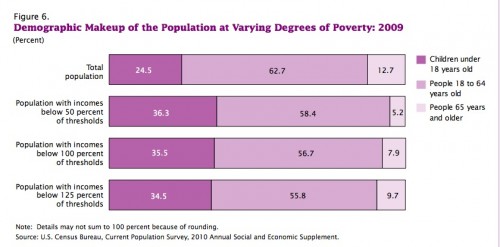Rick T. sent in a link to a post at Global Research about some new U.S. Census data about 2009 poverty rates. As is usually true, children suffer higher levels of poverty than other age groups:
Poverty is significantly higher for African Americans than for the U.S. population overall — notice the Y axis goes up to 45%, whereas above it ends at 30%:
From the post:
Being American gives you a one in seven chance of being poor. Being young raises this chance to one in four. Further, being black in America means a one in four chance of being poor. Being young and black raises your chance of being poor up to one in 2.5.
Not surprisingly, poverty is highly related to education level:
I went to the original Census report and grabbed some more images. This graph makes the over-representation of children among the poor even more obvious:
There’s tons of information in the report if you’re interested in the demographics of poverty in the current economic recession.





Comments 16
P. — October 9, 2010
From time to time you hear politicians (and others) talk about the US being the richest country in the world. Technically that might be so, but looking at the numbers above, it really makes you realize how irrelevant such a statement is for a huge chunk of the population.
Anonymous — October 9, 2010
The disproportionate number of women living in poverty compared to men is staggering. Women make up the majority of the population in the service providing and retail industries, the most vulnerable industries to any downturn of the economy. What happened to that data in this poverty demographic?
PO — October 9, 2010
Any info on poverty related to marriage statistics and out of wedlock births? I've always heard staying in school and having kids only after marriage were the two surest ways to stay out of poverty.
If so, I'd suggest folks start doing that...
Meg — October 9, 2010
Well, it's clear which age group doesn't get to vote, and which further age group is considered unelectable due to "lack of experience."
song — October 9, 2010
Is this due to the ratio of children to caregivers in the most at-risk populations? (Because at least theoretically no child under 14 should have any measurable income, so one presumes this measures income of the children's primary caregiver(s).) And if so, might we look to better access to contraceptives and, given the correlation between education and poverty, early comprehensive sex ed as pieces of an -- admittedly partial -- solution?
Weekly Feminist Reader — October 10, 2010
[...] data on poverty [...]
Uly — October 11, 2010
Have you seen this as well?
http://www.slate.com/id/2270328/
LIE Links | Love Isn't Enough - on raising a family in a colorstruck world — October 12, 2010
[...] 2009 Poverty Demographics [Sociological Images] [...]
Women Can't Drive! » Blog Archive » Weekly Feminist Reader — October 12, 2010
[...] data on poverty [...]
Waiting Room Reading: 10/12 « Welcome to the Doctor's Office — October 12, 2010
[...] 2009 POVERTY DEMOGRAPHICS [...]